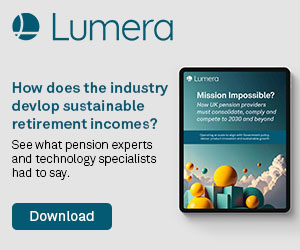Sandra Haurant explains the difficulties of defining ‘absolute returns’ as a concept and the challenge of measuring performance
The concept of absolute returns sounds full of promise. These funds, which come in multiple shapes and sizes, do not aim to beat a particular benchmark or follow a specific index. Their returns will not track the fortunes of the FTSE 100, for example, or the highs and lows of bond markets or global equities. Instead, absolute returns funds aim to provide positive returns in any market, with a performance that is immune, as far as that is possible, from the peaks and troughs of the markets, and they use a variety of tools to provide low-volatility returns over a given period of time.
Fund managers aim for a specified level of returns using cash or another non-market reference as a benchmark, and go for as low a level of correlation with the markets as possible in their pursuit of returns. “Broadly, these types of funds get their returns from two sources,” says PiRho Investment Consulting director Phil Irvine. “Different market risks, such as equity, credit, emerging markets, property, currency, illiquidity premium, leverage and so on, which are hopefully de-correlated most of the time. And skill, through either tactical asset allocation or some versions of long-short. Both sources can provide growth that is needed but it is important for investors to distinguish between the two,” cautions Irvine.
The definition of absolute returns is currently under review by the Investment Management Association (IMA), with the results of that review due to be published (at the time of press). The absolute returns field is broad, and without clear ways to define and categorise absolute returns it becomes very difficult to compare different funds within the sector.
“In practice,” explains Irvine, “categorising funds into neat definitions can be difficult.” PiRho would make a distinction within the absolute return space between three main subsections, he says. These are hedge funds, which in turn have their own sub-categories, diversified growth funds, which are multi-asset and principally long-only funds that have absolute rather than specific market targets, and single asset funds, onshore structures that have gross but not net leverage, such as absolute bond funds.
The hedge fund link
In their various forms, absolute returns funds have been growing in popularity for pensions for some time, although some provoke more concerns than others.
Hedge funds, for example, remain something of a controversial topic for a lot of pension investors still smarting from losses at the start of the crisis.
“There has been something of a pull back from hedge funds since the crisis,” says JLT Consulting consultant Jignesh Sheth. “Most hedge funds lost value in 2008.”
Substantial losses, combined with historic concerns around transparency and liquidity mean hedge funds retain, rightly or wrongly, something of dubious reputation. But while there is some overlap, not all absolute returns funds are hedge funds, and not all hedge funds are absolute returns funds, as plenty are actually benchmarked to the markets.
“Absolute returns funds and hedge funds can be the same, but they are not always,” says Zurich fund strategy director in the corporate saving arm, Jonathan Parker. “Hedge funds cover a whole gamut of investment strategies, right from global macro hedge funds down to bonds or commodities hedge funds, which are doing something very specific. Hedge funds could be said to be an asset class, whereas absolute returns is more a style of investing.”
Zurich’s investment platform does not carry any hedge funds, explains Parker, but it does have a number of absolute returns funds, and, he says: “We have seen them growing in popularity over the past five years.”
Weathering storms
Part of the attraction of absolute returns is their aim to flatten out volatility and create returns when the chips are down. As CQS Diversified Fund co-portfolio manager Peter Warren says: “Over a three to five-year cycle we seek to generate 10 per cent plus per annum net returns, with mid-single digit volatility and as low a correlation as possible.”
This lack of correlation to individual asset classes is the key to the absolute returns riddle – when equities, for example, go down, an absolute returns fund does not necessarily follow suit. The same goes for the bond market. Whatever is happening in one particular asset class, absolute returns funds should, the theory goes, be able to ride it out with a mixture of flexibility and skill. The CQS diversified fund that Warren co-manages was down 7 per cent in 2008 when many correlated funds came a cropper in a big way, and in 2009 it was up by 24 per cent.
Of course, if funds do not track the market downwards, it is fair to assume they will not follow upwards either. “In a strong rally, absolute returns are likely to lag,” says Sheth.
But, what they lack in occasional peaks they aim to make up for with a strong and steady approach. And it is perhaps that aim to protect capital and maintain steady returns that makes them popular with pension funds.
Some are using diversified growth funds as core holdings, while in some cases they are used more as a diversification tool, a satellite holding. “As well as looking at absolute returns in growth portfolios, pension funds are also starting to look at them in terms of bond yields as well in the form of absolute returns bond funds,” says Sheth.
Measurable growth
But while some parts of the pension world are embracing this style of investment, there are those that remain unconvinced that they will deliver the capital protection and reliable returns investors want from them.
One reason for reticence is a difficulty in measuring just how well these funds perform. Many investors are used to being able to judge how an actively managed fund has fared compared to others in its sector by looking at its performance compared with its given benchmark.
Take UK equity income funds, for example. The IMA clearly defines these as “funds which invest at least 80 per cent in UK equities and which intend to achieve a historic yield on the distributable income in excess of 110 per cent of the FTSE All Share yield at the fund’s year end.”
At the time of writing, the IMA’s definition of absolute returns funds says these are: “Funds managed with the aim of delivering absolute (i.e. more than zero) returns in any market conditions.Typically funds in this sector would normally expect to deliver absolute (more than zero) returns on a 12 months basis.”
With no benchmark to compare them to, assessing performance means comparing similar funds against one another. “It is difficult,” says Parker. “Lining up all the funds in the absolute returns sector will give you an idea. But with so many different approaches within the absolute returns space, finding the funds to compare against one another is in itself a challenge, he adds. “There is not much merit in having league tables because you are often comparing apples with pears. A lot depends on a fund managers’ style and wider economic conditions.”
Then there is the question of risks taken to achieve returns and low volatility. “Looking at past performance will not tell you very much about the level of risk that has been taken by a fund,” says Parker.
A point backed up by Irvine, who cautions that low-volatility does not always mean low risk. “These types of funds typically have a great deal of focus on risk management,” Irvine says. “But that doesn’t mean that investors can necessarily rest easy. Generally we would advise that steady performance can disguise increasing risks, and beware a false sense of security that low volatility can bring,” he warns.
Absolute returns funds have earned a place in the portfolios of an increasing number of pensions, and the concept of capital protection against all odds is certainly appealing but clearly the risks need to be understood too. The IMA’s review may bring greater clarity when it comes to defining this area of investment, but one thing is already clear – if it can really deliver then the absolute returns concept of protecting capital and making money in all weathers is one with universal appeal.
Sandra Haurant is a freelance journalist
Latest News
-
Looking back: Top 20 most read stories of 2025
-
‘Growing minority’ of pension savers turning to newer digital channels
-
Border to Coast deploys more than £1bn across private markets programme
-
Looking back: The Pensions Age 2025 DEI focus
-
This week in pensions: 15-23 December
-
Looking back: 2025 - The year of the big pension overhaul
Private markets – a growing presence within UK DC
Laura Blows discusses the role of private market investment within DC schemes with Aviva Director of Investments, Maiyuresh Rajah
The DB pension landscape
Pensions Age speaks to BlackRock managing director and head of its DB relationship management team, Andrew Reid, about the DB pensions landscape
Podcast: From pension pot to flexible income for life

Podcast: Who matters most in pensions?

In the latest Pensions Age podcast, Francesca Fabrizi speaks to Capita Pension Solutions global practice leader & chief revenue officer, Stuart Heatley, about who matters most in pensions and how to best meet their needs
© 2019 Perspective Publishing Privacy & Cookies










Recent Stories